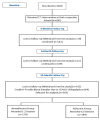Attendance-Based Adherence and Outcomes of Obesity Management Program in Arab Adolescents
- PMID: 37761410
- PMCID: PMC10529466
- DOI: 10.3390/children10091449
Attendance-Based Adherence and Outcomes of Obesity Management Program in Arab Adolescents
Abstract
Pediatric obesity has become a global pandemic in the last century, contributing to short and long-term medical conditions that heighten the risk of morbidity and mortality in children. The 12-month school-based obesity management educational program aims to assess the effect of adherence to the lifestyle educational program and target outcomes, obesity, and hypertension. A total of 363 (nonadherent, N = 179; adherent, N = 184) Saudi school adolescents aged 12-18 were recruited from 60 schools in Riyadh City, Saudi Arabia. Anthropometrics, lipid profile, and blood glucose were measured at baseline and post-intervention. The level of adherence was based on the number of attended educational sessions, and participants were grouped accordingly into two groups: adherent group (attended ≥ 3 sessions) and nonadherent group (attended 1-2 sessions) out of a total of five sessions. Results demonstrated that significantly more participants in the adherent group achieved the primary program goal of reducing obesity indices [body weight, body mass index (BMI), and BMI z-score] than the nonadherent group. Additionally, among adherent obese participants, BMI z-score significantly decreased after the 12-month intervention (post-intervention: 1.5 ± 0.7 vs. baseline: 1.7 ± 0.6, p < 0.05), while the trend in BMI z-score modestly increased in the nonadherent obese participants post-intervention (post-intervention: 1.8 ± 0.7 vs. baseline: 1.7 ± 0.6, p > 0.05). Moreover, there was a substantial reduction in hypertension prevalence only in the adherent group (p = 0.003) and among adherent obese participants in particular (p = 0.03). Furthermore, adherence to session attendance was higher in girls than boys, which led to better outcomes among girls than boys. For the secondary outcomes, lipid profile indices increased in both groups, while no changes were observed in the glycemic profile. In conclusion, greater adherence to educational sessions achieved modest but favorable weight changes and improved blood pressure among obese adolescents. Future intervention studies should take into consideration the need to improve attendance to enhance adherence to the program among adolescents at risk.
Keywords: adherence; adolescents; educational program; lifestyle; obesity.
Conflict of interest statement
The authors declare that they have no competing interests.
Figures
Similar articles
-
The effectiveness of web-based programs on the reduction of childhood obesity in school-aged children: A systematic review.JBI Libr Syst Rev. 2012;10(42 Suppl):1-14. doi: 10.11124/jbisrir-2012-248. JBI Libr Syst Rev. 2012. PMID: 27820152
-
Cardiometabolic Effects of a 12-Month, COVID-19 Lockdown-Interrupted Lifestyle Education Program for Arab Adolescents.Front Pediatr. 2022 Jun 9;10:887138. doi: 10.3389/fped.2022.887138. eCollection 2022. Front Pediatr. 2022. PMID: 35783315 Free PMC article.
-
Adherence to a Multidisciplinary Lifestyle Program for Patients With Atrial Fibrillation and Obesity: Feasibility Study.JMIR Form Res. 2022 Apr 29;6(4):e32625. doi: 10.2196/32625. JMIR Form Res. 2022. PMID: 35486435 Free PMC article.
-
[Simple obesity in children. A study on the role of nutritional factors].Med Wieku Rozwoj. 2006 Jan-Mar;10(1):3-191. Med Wieku Rozwoj. 2006. PMID: 16733288 Review. Polish.
-
Offspring body size and metabolic profile - effects of lifestyle intervention in obese pregnant women.Dan Med J. 2014 Jul;61(7):B4893. Dan Med J. 2014. PMID: 25123127 Review.
Cited by
-
Dose Intervals and Time since Final Dose on Changes in Metabolic Indices after COVID-19 Vaccination.Vaccines (Basel). 2023 Nov 23;11(12):1746. doi: 10.3390/vaccines11121746. Vaccines (Basel). 2023. PMID: 38140151 Free PMC article.
-
Circulating fibroblast growth factor-21, Omentin-1, and betatrophin and their association with metabolic parameters in Saudi adolescents post 12-month lifestyle change program.BMC Pediatr. 2025 Jul 1;25(1):482. doi: 10.1186/s12887-025-05833-z. BMC Pediatr. 2025. PMID: 40597046 Free PMC article.
-
Trends and characteristics of the metabolically healthy obese phenotype in an Arab population.Front Public Health. 2024 Jul 31;12:1371359. doi: 10.3389/fpubh.2024.1371359. eCollection 2024. Front Public Health. 2024. PMID: 39145170 Free PMC article.
-
Assessment of School Contributions to Healthy Eating, Physical Activity Education, and Support for Weight-Loss Attempts among Adolescents from Jazan, Saudi Arabia.Nutrients. 2023 Nov 5;15(21):4688. doi: 10.3390/nu15214688. Nutrients. 2023. PMID: 37960341 Free PMC article.
-
Prospective changes in lipocalin-2 and adipocytokines among adults with obesity.Sci Rep. 2025 Aug 6;15(1):28794. doi: 10.1038/s41598-025-14091-z. Sci Rep. 2025. PMID: 40770402 Free PMC article.
References
-
- World Health Organization Noncommunicable Diseases. [(accessed on 15 June 2023)]. Available online: https://www.who.int/news-room/fact-sheets/detail/noncommunicable-diseases.
Grants and funding
LinkOut - more resources
Full Text Sources


